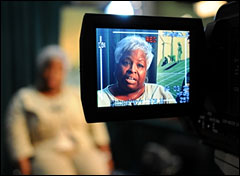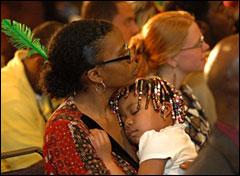Pat Walters is a freelance journalist based in Memphis. He’s captivated by stories about ecology, landscape, and culture. His work has appeared in publications including The St. Petersburg Times and The New York Times Magazine. And he’s very happy his job is green.

Friday, 11 Apr 2008
MEMPHIS, Tenn.
To read more Grist coverage of the Dream Reborn conference, see Walters’ dispatches from day one and day two, and recent reflections by Louisville, Ky.-based writer Jennifer Oladipo.

Van Jones.
Photo: Green for All
When the Dream Reborn green-collar jobs conference ended last Sunday, everyone was singing. There must have been 600 people belting out “This Little Light of Mine.” During the weekend, while reporting on the conference for Grist, I’d compared it to a sports event. But really, it ended up feeling more like a church. I think that’s what organizer Van Jones meant for it to feel like. “There was a time,” he said Friday, “when we led our marches out of church houses.”
This spiritual energy had a lot to do with when and where the conference happened. It began last Friday, on the 40th anniversary of Dr. Martin Luther King Jr.’s death, in Memphis, just a few blocks from the place he was killed. King came to Memphis in 1968 to march with striking sanitation workers. The signs they held — “I AM A MAN” — demanded fair wages. Particularly in his later years, King pressed not only for racial equality, but also for justice, nonviolence, and economic fairness for all people.
The Dream Reborn postured itself as a 21st-century extension — or rebirth — of that vision. It was put on by Green for All, the green-collar jobs advocacy group launched last year by Van Jones, founder of Oakland, Calif.’s Ella Baker Center for Human Rights, and Majora Carter, founder of Sustainable South Bronx.
The aim of Green for All — whose partners include the Apollo Alliance, the Center for American Progress, and the Energy Action Coalition — is to raise a billion dollars for green-collar job training by 2012. In doing so, its founders hope to pull 250,000 Americans out of poverty.
It’s a bold mission, to be sure. And the stakes may be higher than ever.
After the conference ended, I opened a back issue of Orion and happened to come across a 2006 interview with Jones. Part of it helped me understand how this new piece of the fight for human rights — and environmental ones — is different from what has come before. Old revolutions, Jones said, were about rising up and taking control; picture the slaves on the Amistad. New ones, though, are complicated by environmental crises like global warming; imagine a version of the Amistad that’s sinking like the Titanic.
It’s a fatalistic image. But for Jones, it’s a challenge, an articulation of the scale of the problem the green-collar jobs movement intends to solve: “Now you’ve got to not only liberate the captives, you also have to save the ship.”
The conference, which drew more than a thousand people, channeled King’s message — his words punctuating one speech after another — but also repurposed it for a new era, fusing the struggles to protect human rights and the natural world.
The green-collar jobs movement — increasingly cited by the leading presidential contenders and the media following them, but still not widely understood — seeks to fill the jobs created by the emerging green economy with people from low-income urban neighborhoods. These are the places that so often suffer the worst environmental devastation, and the idea is to give residents a fair wage and, by focusing their green efforts close to home, a cleaner place to live.

Throughout the weekend, participants shared their dreams on video.
Photo: Green for All
In an interview with Grist last year, Jones put it simply: “All the big ideas for getting us onto a lower carbon trajectory involve a lot of people doing a lot of work.” Green for All began with the creation of a local green-collar jobs corps. Many of these jobs fall into two categories: installing and manufacturing. We need carpenters, electricians, and masons to put in solar panels, insulation, and wind turbines. And before that can happen, we need people to build those things.
The green economy is creating millions of new jobs — according to Green for All, 2006 alone saw the creation of 8.5 million of them — but it’s also replacing old ones. Two years ago, Spanish wind-turbine giant Gamesa moved into a vacant steel plant in Ebensburg, Pa., not far from Levittown, that iconic planned community built for the post-war industrial middle class. The company hired 230 local workers.
Last month, the BlueGreen Alliance, a project of the Sierra Club and the United Steelworkers of America, held the first national green-jobs conference in Pittsburgh. (See Grist’s extensive coverage of that event here.) Seeing an opportunity, Gamesa sent representatives to the conference — to hire welders.
But the continued creation of good, middle-class green jobs depends on the growth of the green economy. It depends on green companies expanding, and moving into parts of America that aren’t doing so well — and haven’t been hiring.
Gamesa’s decision to set up shop in Pennsylvania had a lot to do with state incentives for renewable energy companies. On the other side of the country, California’s Global Warming Solutions Act — known as AB 32 — incited widespread changes that should lead to the creation of tens of thousands of green-collar jobs in the state. And last year, Congress passed the Green Jobs Act of 2007, authorizing $125 million for green-collar job training programs.
Advocates hope support from the federal government will only increase after the presidential election, no matter who wins — all three remaining candidates have expressed support for green-collar jobs. But for the moment, the movement is based in hundreds of small projects in dozens of cities throughout the country. Representatives of many showed up in Memphis last weekend. Here are a few efforts I found especially inspiring:
Sustainable South Bronx: Of all the projects represented at the conference, this one has probably gotten the most national media attention. It’s well deserved. Majora Carter floored me as she tearfully described the desperation that, four years ago, led her to form Bronx Environmental Stewardship Training, one of the first green-collar job training programs in the country — and still one of the most successful.
White Earth Land Recovery Project: Founded by well-known environmental activist and Ojibwe tribe member Winona LaDuke, this group is working to recover all the land originally included in the White Earth Indian Reservation. Along the way, LaDuke and her colleagues have taken big steps toward localizing the tribe’s economy by building wind turbines, installing solar panels, and encouraging people to eat food grown locally. They’ve created dozens of green-collar jobs.
Milwaukee Energy Efficiency (Me2): Large companies are often able to obtain guarantees from contractors that retrofitting for energy efficiency will save them a given amount of money. This project, established in part by University of Wisconsin-Madison professor Joel Rogers, will make that strategy available to individuals — even renters — by allowing them to pay off retrofitting costs over time, directly through their energy bills. More energy-efficient retrofitting equals more green-collar jobs.
RichmondBUILD: Officials in Richmond, a small California city a couple miles north of Berkeley and home of the first Green Party mayor in America, are teaching residents how to install solar panels. Publicly funded programs like this one are rare. The program focuses on “at-risk” employees — former inmates, for instance. Program administrator Sal Vaca said more than 90 percent of participants find jobs: “One guy even drives a company car.”
Lincoln Park Coast Cultural District: Revitalization is good. Gentrification is bad. Baye Adofo-Wilson is trying to strike a balance in redeveloping a once down-and-out neighborhood in Newark, N.J. When it’s finished, the four-block, mixed-income, mixed-use neighborhood will have 300 units of green housing, artists’ studios, galleries, and restaurants, and a Museum of African American Music. All of it is being built by local green-collar workers.

Dreaming of a greener future.
Photo: Green for All
Consider the backgrounds of the people behind those projects: a community activist, a tribal leader, an academic, a city official, and an urban planner. Collaboration between all sorts of different people is going to be key to the success of the green-collar jobs movement. The energy I felt last weekend convinced me this sort of unity is more than possible; it’s inevitable. Hundreds of people sang and chanted and hugged one another. All different races. All ages.
But no amount of singing is going to gloss over the need for, as one presenter put it, “green, dough, scratch.” At the end of the day — literally — it’s all about the money. After the singing ended, Jones and his staff took up a collection. “It wouldn’t be Sunday,” he said, “if a black man in a suit didn’t stand up and ask you for some money.” Jones laughed when he said this, but it was clear that the financial needs of the green-collar jobs movement are serious. Even the Green Jobs Act — which Jones admits is “just a start” — won’t do any good unless Congress appropriates funds for it later this year.
But from a purely logical perspective, green-collar jobs look pretty good. Help people make their way out of poverty. Clean up the environment. Support the growing green economy. I’m having trouble seeing the downside.


